The AMD Radeon VII Review: An Unexpected Shot At The High-End
by Nate Oh on February 7, 2019 9:00 AM ESTProfessional Visualization and Rendering
With AMD strongly pushing the Radeon VII as a prosumer content creation card, it behooves us to look at rendering, CAD, and professional visualization performance. However, accurate and applicable benchmarks for this field are not so easy to find, especially since performance is highly dependent on workflow and proprietary licensed ISV software. Given AnandTech’s audience, which often includes engineers using these applications in critical production environments, our goal is to provide the most relevant metrics. However, as Ian has discussed previously, the route to the most accurate workstation benchmarking for professional applications is in the hands of ISVs, who are at best blasé and more typically negative about providing access, even at the prospect of lending limited software licenses in return for ongoing discussion and third-party benchmark data of their software.
Those caveats in mind, the next best thing for evaluating overall GPU workstation performance is the venerable SPECviewperf, recently updated to version 13. Separated into ‘viewsets,’ which are a group of application-specific workloads derived from real-world datasets, SPECviewperf has been a longstanding suite for generalized workstation/CAD GPU performance. For SPECviewperf 13, the viewsets are based on:
- Autodesk 3ds Max 2016 (Nitrous DX11 driver)
- Dassault Systèmes CATIA V6 R2012
- PTC Creo 3 & Creo 4
- Geosurvey software, with workloads based on rendering techniques utilized by the open-source OpendTect seismic visualization application
- Autodesk Maya 2017
- Radiological (i.e. CT, MRI scans) rendering, with workloads using the Tuvok rendering core of the ImageVis3D volume visualization application
- Autodesk Showcase 2013
- Siemens NX 8.0
- Dassault Systèmes Solidworks 2013 SP1
While we didn’t have time for complete benchmarking of video editing/production software such as Adobe Premiere Pro CC, we will be looking to include that in the future.
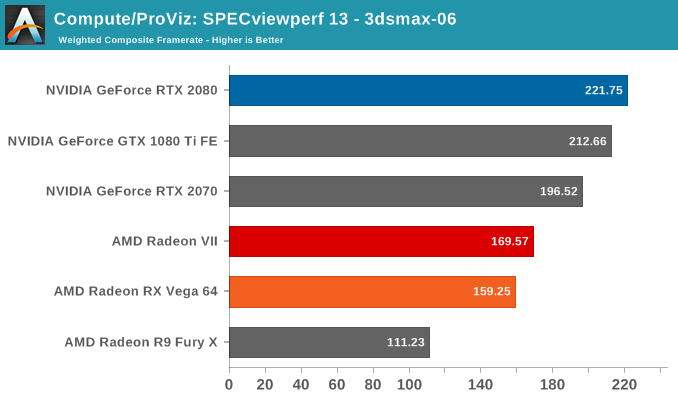
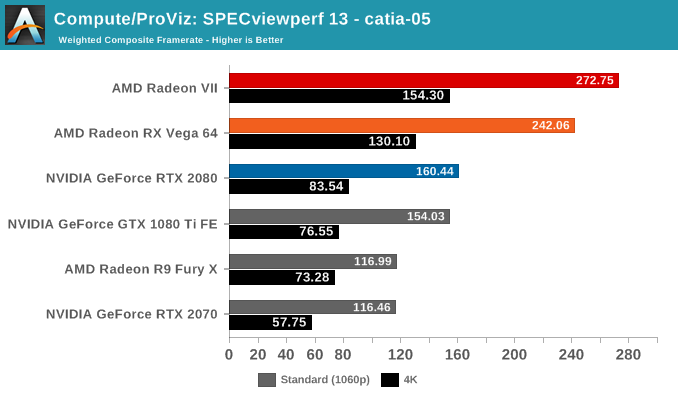

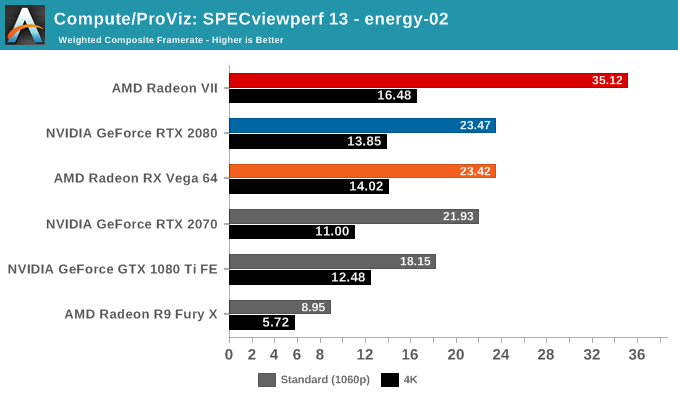
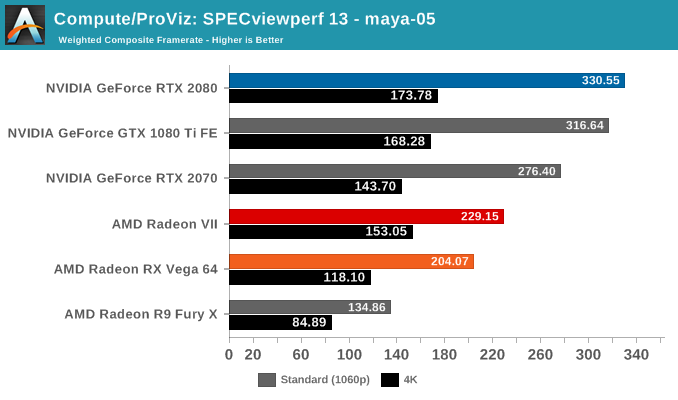
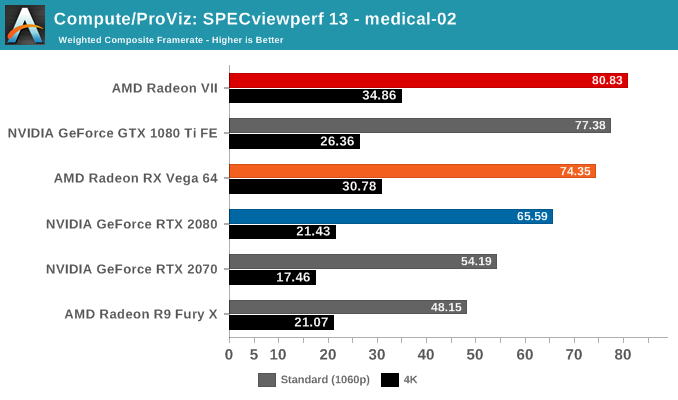
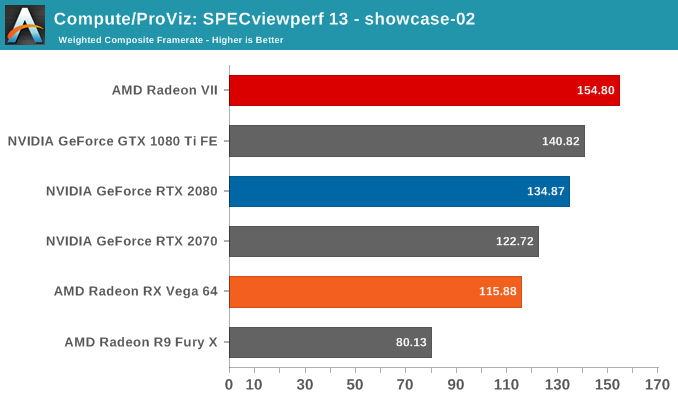
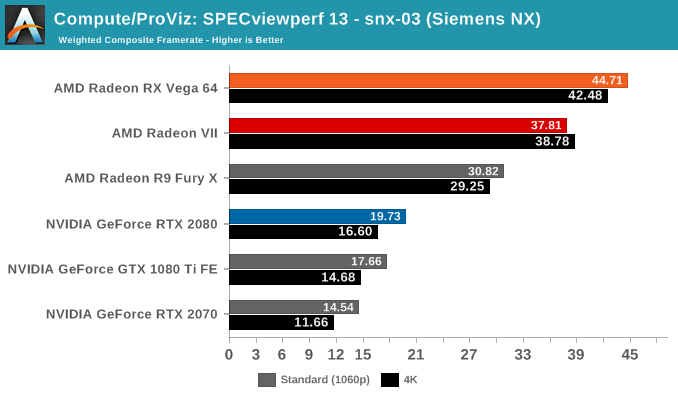
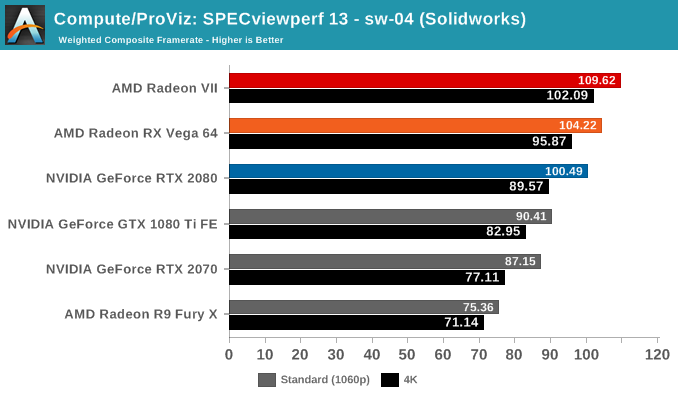
Looking over the results, it's clear that certain viewsets tend to perform better on one vendor's hardware than the other's. In those cases, the Radeon VII doesn't buck the trend, though in Siemens NX the lower performance is more likely than not related to driver maturity. In the reverse scenarios like in creo-02 or maya-05, the Radeon VII is in a similar spot, naturally ahead of the RX Vega 64 but behind the competing RTX and GTX cards. If anything, the results highlight the importance of software maturity for newer hardware, but there are definite signs of Vega 20 being a powerful workstation card. The caveat is that it doesn't seem to change the overall landscape for worksets that traditionally perform well on NVIDIA hardware.
Our next set of benchmarks look at rendering performance. To be clear, given the nature of ‘render wars’ as well as the adoption of CUDA, the featured render engines are not necessarily indicative of the overall GPU renderer landscape. Because we are looking at the Radeon VII, it’s not applicable to include some of the more popular renderers, such as Redshift and Octane, which are CUDA-only, and similarly the presence of Indigo Renderer helps as another datapoint even though it is less popular.


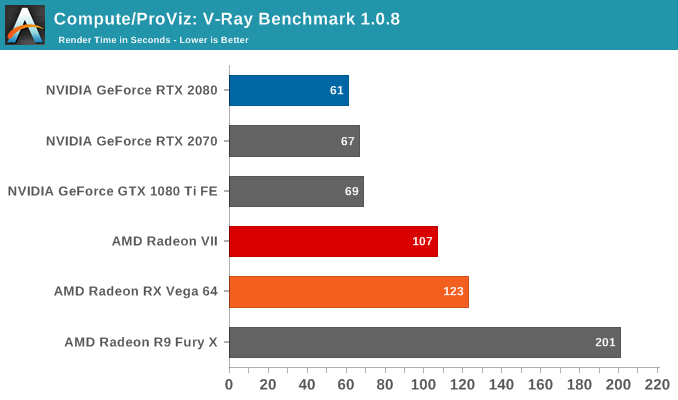

To note, official Blender releases have yet to incorporate CUDA 10, and so RTX 20 series cards are not officially supported.
V-RAY here is the only test that utilizes CUDA for NVIDIA cards, while the rest all use OpenCL. The results seem broadly similar to SPECviewperf, where the Radeon VII continues to excel at workloads where AMD hardware generally fare well.










289 Comments
View All Comments
eva02langley - Thursday, February 7, 2019 - link
I think you are the one in denial over this.This is a Radeon Instinct M150. This is a compute card that was never intended to be a gaming card. The biggest integration AMD had to do were drivers. Drivers will indeed be better in the next 3 months.
yasamoka - Thursday, February 7, 2019 - link
So please explain why AMD are designating this as a gaming card. I explained this in my previous post. Their lack of product differentiation is exhausting them and the apologetic acrobatics pulled by their die-hard fanboys is appallingly misleading. This is the same Vega architecture. Why isn't AMD releasing their cards with the drivers optimized beforehand? They have been doing this since the 7970. Remember that card getting beat by the GTX 680 just because they had unoptimized drivers? It took AMD almost a year to release drivers that thoroughly bested that series. CrossFire performance on these was also way ahead of SLi. It took them around another year to solve microstuttering. I had 2x 7970's back then. These delays need to stop, they're literally murdering AMD's product launches.Bp_968 - Thursday, February 7, 2019 - link
Nvidia is also guilty of the same thing. The entire Turing lineup is a die designed and R&Ded for the Enterprise customers. The "flagship features" they keep raving about for Turing are slapped together ways to use all the ASIC cores on the dies designed for AI and content creation.Its why when you compare a 1080 to a 2070, or a 1080ti to a 2080 (the same price bracket) you get almost zero rasterization improvements. Its a huge and expensive die reused from the enterprise department because no one else has anything competitive in the same space.
Nvidia is likely holding back their actual 12nm/7nm gamer design for 2020 out of concern for what Intel might have and possible concern over Navi. I also think Nvidia vastly underestimated how poorly the repackaged cards would sell. I expect Turing to be a very short generation with the next series being announced in late 2019 early 2020 (depending on what intel and AMD end up fielding).
Alistair - Thursday, February 7, 2019 - link
exactly!ToyzRUsKid - Friday, February 8, 2019 - link
The updated NVENC encoder chip may become a major selling point for the RTX cards for streamers/content creators. I'm actually disappointed Nvidia is not emphasizing this feature more. Once OBS Studio releases their new build that will further increase NVENC encoding efficiency it will create an even more compelling argument to switch to NVENC.I have been testing the new encoder and it's rivaling and beating medium preset x264 at 1080p60 using 8k bitrate. Single pc streamers will see steam quality improvements along with massive cpu resource savings. I'm of the opinion the dark horse selling point of these cards will be the new NVENC encoder. It appears the Turning generation is more of an advancement for content creators than the average gamer. Ray tracing is superfluous at this point for sure.
I'm ok with this. I still run a 1080Ti in my gaming rig and I'm comfortable waiting another generation. But the RTX 2070 in my streaming rig is delivering the best quality stream to date. That is comparing against x264 medium running on an i9 9900k@5GHz. This flies in the face of conventional wisdom and people with more credibility than me will need to help change the winds here. But this is my anecdotal experience.
rahvin - Friday, February 8, 2019 - link
If and I mean IF nvidia is holding back it's a purely financial move due to the huge overstock on GPU's caused by crypto currencies. Both AMD and nvidia massively underestimate how much demand crypto was creating. (IIRC AMD said during the earnings call now that crypto has dropped off that monthly GPU sales are less than half what they were) Supposedly there are more than 100K of nvidia cards (again the stuff I saw said that was somewhere between 3-6months normal gamer sales) sitting out there on store shelves rotting because of it, and it's so bad nvidia is having to take stock back from retailers that want the shelf space freed up.That's prime incentive to sit on the designs until the existing stock is used up. For both nvidia and AMD. Sure they might push out some high end high price product but they aren't doing anything in the middle of the market until that stock is cleared out.
Korguz - Thursday, February 7, 2019 - link
yasamoka...at the least.. this could force, what seems to be your saint nvida.. to drop the price of their cards.. as it stands before today.. ALL of their 20 series cards.. are out of the price range i would pay for a video card, or are pushing it/hard to justify the cost over my current 1060, as the 1070/80 were way out of my price range..
D. Lister - Thursday, February 7, 2019 - link
@KorguzThe RVII performs 5%-6% below the 2080 (as per this review) and yet is priced the same. How is that going to force Nvidia to cut prices?
Korguz - Friday, February 8, 2019 - link
well.. where i am at least.. the radeon 7 starts at 949 ( preorder ), only 2 cards listed, Asus and xfx. the gtx 2080 ( which the radeon 7 is aimed at ) starts at 1130, almost 200 more... IMO.. 200 is not worth the premium for a 5-6% faster card.. the top of the line 2080 is the GeForce RTX 2080 SEA HAWK X which is priced at $1275... for my cash... id be looking at the radeon 7.. and saving 200+ bucks to use some where else in my comp...TheinsanegamerN - Thursday, February 7, 2019 - link
The Instinct M150 is a VEGA class card, the architecture is incredibly similar to Vega 56/64. There are not massive gains to be made here.If there are, then AMD must be completely incompetent at driver management.